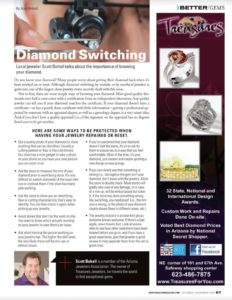Diamond switching: The importance of knowing your diamond
Local jeweler Scott Bohall talks about the importance of knowing your diamond.
Do you know your diamond? Many people worry about getting their diamond back when it’s been worked on or reset. Although diamond switching by mistake or by unethical jewelers is quite rare, one of the largest chain jewelry stores recently dealt with this issue.
Not to fear, there are some simple ways of knowing your diamond. Most good quality diamonds over half a carat come with a certification from an independent laboratory. Any quality jeweler can tell you if your diamond matches the certificate. If your diamond doesn’t have a certificate––or has a poorly done certificate with little information––getting a professional appraisal by someone with an appraisal degree, as well as a gemology degree, is a very smart idea. And, if you don’t have a quality appraisal (i.e., if the signature on the appraisal has no degrees listed next to it) get another.
Here are some ways to be protected when having your jewelry repaired or reset.
- Get a quality photo of your diamond to show anything that can be identified. Usually a cutting pattern or flaw is like a birthmark. Our store has a nice gadget to take a photo on your phone so you have your own picture you can zoom in on.
- Ask the store to measure the mm of your diamond prior to work being done. It’s very difficult to switch diamonds of the exact mm size or confuse them if the store has many jobs working.
- Ask the store to show you an identifying flaw or cutting characteristic that’s easy to identify. You can then check it again when picking up your jewelry.
- Avoid stores that don’t do the work on site. You want to know who’s actually working on your jewelry in case there’s an issue.
- Ask what training the person working on your jewelry has. The higher the skill level, the less likely there will be mix-ups or ethical issues.
- If you’re concerned that your diamond doesn’t look the same, it’s ok to ask for them to assure you in a way that you feel comfortable. Most of the time, it’s your diamond, just cleaner and maybe sporting a new design or new prongs.
- If you can clearly see that something is wrong (i.e., damage) or the gem isn’t your diamond, don’t leave with the jewelry. Allow the store to double check. Most stores will gladly take care of any damage, or in case of a mix-up, will be embarrassed but solve it. If the store has done something wrong, like switching, you need proof (i.e., the mm size is wrong, or the photo of your diamond clearly shows flaws in different areas, etc.)
- The jewelry industry is a close-knit group; everyone knows everyone. If there’s a bad apple, news travels fast. Look at review sites to see how other customers have been treated before you go in, and if you have a great experience, give that jeweler a good review to help separate them from the not so great ones.
Related posts
Leave a Comment
You must be logged in to post a comment.







